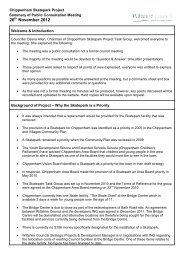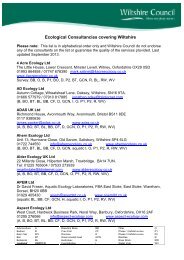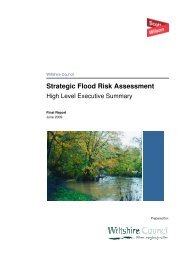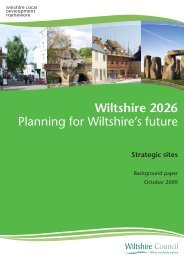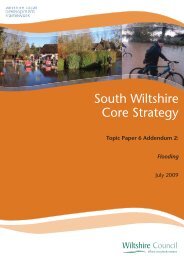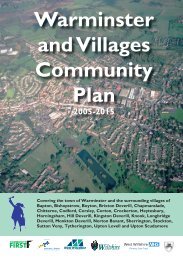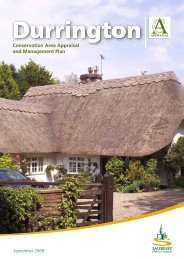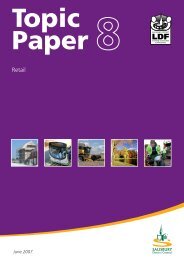South Wiltshire Core Strategy - Wiltshire Council
South Wiltshire Core Strategy - Wiltshire Council
South Wiltshire Core Strategy - Wiltshire Council
You also want an ePaper? Increase the reach of your titles
YUMPU automatically turns print PDFs into web optimized ePapers that Google loves.
4.10(c) Sport, Leisure and Recreation<br />
There is a shortfall of recreational open space across south <strong>Wiltshire</strong>. There is also<br />
pressure from development on both formal and informal open space, especially in<br />
Salisbury and Amesbury 36 .<br />
4.11 The challenge of climate change<br />
This presents a tough challenge for south <strong>Wiltshire</strong>. The predominantly rural<br />
character of the area often makes access to a range of services extremely difficult<br />
and increases reliance on the private motor car. This in turn can have a major impact<br />
on CO 2 emissions which are the main greenhouse gas that contributes to climate<br />
change. These emissions can also have an impact on air quality particularly in the<br />
urban area of Salisbury city centre. As well as providing more sustainable transport<br />
choices, there is a necessity to facilitate the increased use of renewable and low<br />
carbon energy sources. Together these can go some way towards reducing south<br />
<strong>Wiltshire</strong>’s dependency on fossil fuels. Enabling this type of development has to be<br />
balanced against the challenge of protecting the high quality of the built and natural<br />
environment. Ensuring that development is resilient to the effects of climate change<br />
is also important. Measures are needed to safeguard water quality and reduce water<br />
consumption and deal with increased flood risk 37 .<br />
4.12 Tackling infrastructure barriers to delivering growth<br />
A major challenge is ensuring that infrastructure is adequate to support the level of<br />
growth required to meet local needs 38 . Key infrastructure challenges for the area are:<br />
• Congestion and safety problems on the major transport corridors of the A303 and<br />
A350<br />
• Pressure on the Salisbury ring road<br />
• How to provide meaningful alternative transport choices to the private motor car<br />
• Added pressures on the sewage network around Salisbury<br />
• Increased phosphate levels in the local watercourses.<br />
• Ensuring adequate water supply.<br />
• Ensuring that the emergency services can respond adequately to new areas of<br />
growth.<br />
• Addressing the additional demand for healthcare in Salisbury<br />
• Added pressures on school capacity.<br />
• How to provide renewable energy either on or near new development sites.<br />
4.13 Conclusions and Next Steps<br />
This chapter has set out the key challenges that the evidence-based approach has<br />
highlighted as facing south <strong>Wiltshire</strong>, now and in the future. The remainder of this<br />
<strong>Strategy</strong> will set out how, through a delivery focussed approach, these barriers can<br />
be overcome to allow progress towards a shared vision of where south <strong>Wiltshire</strong> will<br />
be in 20 years time.<br />
36 Salisbury District <strong>Council</strong> Open Space Study by PMP, July 2007 - Executive Summary pages i to iv<br />
37 See Topic Paper 1, 'Climate Change' & first and second addenda thereto.<br />
38 See Topic Paper 17, 'Infrastructure'<br />
22



